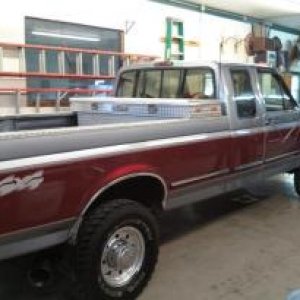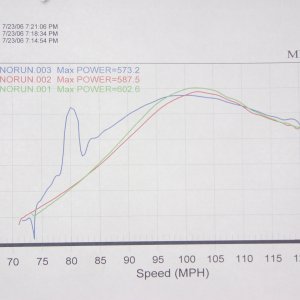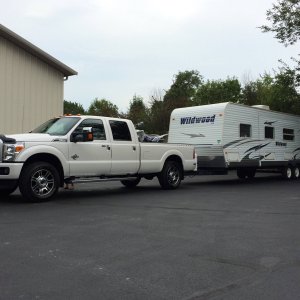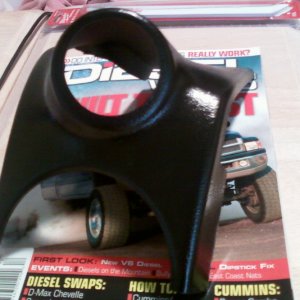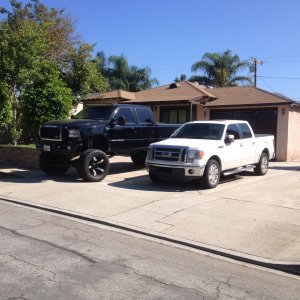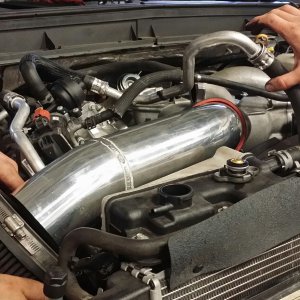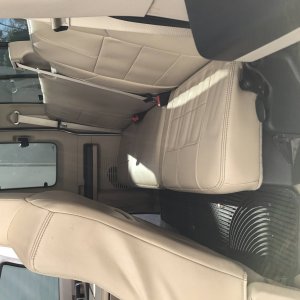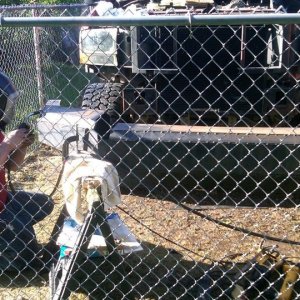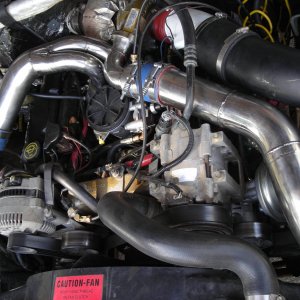SIX_OHH
In the Brig (Banned)
- Joined
- May 18, 2011
- Messages
- 2,306
- Reaction score
- 0
The EVRT (Electronic Variable Response Turbocharger) is also known as a VGT or variable geometry turbocharger. It improves upon turbocharger design by changing the size of the vanes in the turbine housing, allowing control of boost by controlling exhaust turbine inlet pressure. The size of vanes changes positively as engine speed increases. At low engine speeds, the increased pressure generates higher boost than traditional turbine design.
The Garrett turbocharger changes exhaust air pressure by using piston to rotate a cam that rotates a unison ring which pivots the vanes. Pivoting these vanes controls the size of the opening between the vanes thus controlling the pressure of the exhaust gasses in the turbine housing. The trouble with this design is that surface rust and carbon build-up can cause the unison ring or the vanes to bind or seize in the housing. The position of the vanes when this occurs will determine whether a low boost or an over boost condition will occur. Typically this requires replacement of the turbocharger however we have discovered that many turbochargers can be successfully reconditioned and returned to service.
The technicians that work for International are instructed to recondition turbochargers on the VT-365 engine using service bulletin 201055 which also contains the part number (#03050) for the 3M Resurfacing Kit. On August 10, 2006 Ford motor Company released TSB 06-17-1 which is their version of the turbocharger reconditioning procedure which is slightly different than International's version. Ford wants several inspections performed before any cleaning is to be done and mentions cleaning coking deposits only. Are we to assume that light surface rust mandates replacing the turbo? We feel that this is a valid question considering the number of turbos that are actually sticking due to rust. The TSB also instructs technicians to NOT use an anti-seize compound which a light coating will help protect the metal surfaces from rusting. Your own common sense and best judgment is recommended. Instead use any type of motor oil thats clean, diesel or gas version. The oil can be applied to the Unison ring. From a finger dip or dip the whole unison ring. Your choice, Lastly, The TSB requires replacement of the VGT Solenoid which has been revised for improved turbocharger oil control.
We thought we would try this procedure and demonstrate it for you. Our results were positive. The first step is to acquire two 3M® 2” finishing disk arbors also supplied in 3M® kit #030050, extra finishing disks, a paint pen, emery paper and some Scuff pads. One of the arbors will need to be ground down to 1" in diameter or a little less. We found that a scraper mounted in a bench vise made quick work of the modification and the disks can be ground down on any hard surface like the edge of a metal work bench.

Disassembly
Begin by placing the turbo on a bench with the turbine (exhaust) side facing up. It is recommended to cover or, plug or cap the compressor housing openings and the oil passages to protect them from debris. Using the paint pen mark the orientation of the V-clamp and remove the clamp. Next mark the turbine housing to help line up the housing during assembly. Turn the turbocharger over then lift the main assembly off of the turbine housing. You might need to gently tap the housing with a hammer. It is recommended that you mark the location of the slot in the unison ring that mates with the actuator cam for easier assembly.


Inspection
Once separated it's inspection time. What you see in these pictures is typical of a stuck VGT. Rust and carbon can build-up around the center of the housing where the unison ring is centered. On this particular turbocharger three of the vanes were completely stuck and required a little force to break them free. The photo on the bottom right is an example of excessive rust and scaling. If the turbocharger has a little bit of scaling proceed to the cleaning procedure and inspect for excessive pitting afterwards. Otherwise, replace the turbocharger. Replacement will also be necessary if there is excessive wear of the unison ring or the cam pin.




Cleaning
Always use a dust mask when cleaning carbon and rust from the turbocharger! With the 2" disk clean the surfaces of the housing including the center where the unison ring is centered. Cleaning the outer edges will allow for easy assembly. Clean the unison ring including the inner and outer ring edges. Using the emery cloth and scuff pads clean the recessed cam area, cam and the pin. Be careful to not heavily gouge or remove metal. The emery cloth and scuff pads are also good for cleaning the posts that the vanes attach to as well as getting into any hard to clean corners. As the cleaning pads wear they will begin to polish out their own scratches and creates a nice smooth surface.


Change over to the small 1" cleaning disk and clean the surface of the turbine housing as shown. As for the vanes we recommend using the scuff pad and parts cleaner as available. Do not machine them. When finished, clean all parts with Brakleen and dry with compressed air. Reinstall all of the vanes and adjust them evenly. We found it easier to leave them open and close them to align with the unison ring as it is placed over them. This is where marking the position of the actuator cam on the turbine housing will prove to be helpful when installing the unison ring.


Assembly
It is recommended that a very light coat of clean motor oil be applied to the turbine housing and the inner surface of the unison ring. This is to coat and protect the metal from rusting and not to lubricate the unison ring and vanes. At this time you need to verify the movement of the unison ring and vanes. Play this short video clip at the end of paragraph. Observe the free movement of the vanes and the change in the opening between them. In Windows Media Player you can slow down the clip to really study the operation. Verify that the actuator cam also move freely. Once satisfied with the restored free movement continue to finish the assembly. Leaving the turbine housing on the bench, lower the turbocharger over the unison ring paying attention to the alignment of both the housing and the cam pin. Reinstall the v-clamp torquing the nut to 160 in-lb, then loosening and re-torquing to 150 in-lb. Reinstall the turbo assembly as per the shop manual using a new oil inlet gasket and drain tube o-rings.



Do not use anti sieze!!
Instead use a clean motor oil
Taken from diesel technichian society. Re-editted by Smut 7/22 *PSA*
The Garrett turbocharger changes exhaust air pressure by using piston to rotate a cam that rotates a unison ring which pivots the vanes. Pivoting these vanes controls the size of the opening between the vanes thus controlling the pressure of the exhaust gasses in the turbine housing. The trouble with this design is that surface rust and carbon build-up can cause the unison ring or the vanes to bind or seize in the housing. The position of the vanes when this occurs will determine whether a low boost or an over boost condition will occur. Typically this requires replacement of the turbocharger however we have discovered that many turbochargers can be successfully reconditioned and returned to service.
The technicians that work for International are instructed to recondition turbochargers on the VT-365 engine using service bulletin 201055 which also contains the part number (#03050) for the 3M Resurfacing Kit. On August 10, 2006 Ford motor Company released TSB 06-17-1 which is their version of the turbocharger reconditioning procedure which is slightly different than International's version. Ford wants several inspections performed before any cleaning is to be done and mentions cleaning coking deposits only. Are we to assume that light surface rust mandates replacing the turbo? We feel that this is a valid question considering the number of turbos that are actually sticking due to rust. The TSB also instructs technicians to NOT use an anti-seize compound which a light coating will help protect the metal surfaces from rusting. Your own common sense and best judgment is recommended. Instead use any type of motor oil thats clean, diesel or gas version. The oil can be applied to the Unison ring. From a finger dip or dip the whole unison ring. Your choice, Lastly, The TSB requires replacement of the VGT Solenoid which has been revised for improved turbocharger oil control.
We thought we would try this procedure and demonstrate it for you. Our results were positive. The first step is to acquire two 3M® 2” finishing disk arbors also supplied in 3M® kit #030050, extra finishing disks, a paint pen, emery paper and some Scuff pads. One of the arbors will need to be ground down to 1" in diameter or a little less. We found that a scraper mounted in a bench vise made quick work of the modification and the disks can be ground down on any hard surface like the edge of a metal work bench.
Disassembly
Begin by placing the turbo on a bench with the turbine (exhaust) side facing up. It is recommended to cover or, plug or cap the compressor housing openings and the oil passages to protect them from debris. Using the paint pen mark the orientation of the V-clamp and remove the clamp. Next mark the turbine housing to help line up the housing during assembly. Turn the turbocharger over then lift the main assembly off of the turbine housing. You might need to gently tap the housing with a hammer. It is recommended that you mark the location of the slot in the unison ring that mates with the actuator cam for easier assembly.
Inspection
Once separated it's inspection time. What you see in these pictures is typical of a stuck VGT. Rust and carbon can build-up around the center of the housing where the unison ring is centered. On this particular turbocharger three of the vanes were completely stuck and required a little force to break them free. The photo on the bottom right is an example of excessive rust and scaling. If the turbocharger has a little bit of scaling proceed to the cleaning procedure and inspect for excessive pitting afterwards. Otherwise, replace the turbocharger. Replacement will also be necessary if there is excessive wear of the unison ring or the cam pin.
Cleaning
Always use a dust mask when cleaning carbon and rust from the turbocharger! With the 2" disk clean the surfaces of the housing including the center where the unison ring is centered. Cleaning the outer edges will allow for easy assembly. Clean the unison ring including the inner and outer ring edges. Using the emery cloth and scuff pads clean the recessed cam area, cam and the pin. Be careful to not heavily gouge or remove metal. The emery cloth and scuff pads are also good for cleaning the posts that the vanes attach to as well as getting into any hard to clean corners. As the cleaning pads wear they will begin to polish out their own scratches and creates a nice smooth surface.
Change over to the small 1" cleaning disk and clean the surface of the turbine housing as shown. As for the vanes we recommend using the scuff pad and parts cleaner as available. Do not machine them. When finished, clean all parts with Brakleen and dry with compressed air. Reinstall all of the vanes and adjust them evenly. We found it easier to leave them open and close them to align with the unison ring as it is placed over them. This is where marking the position of the actuator cam on the turbine housing will prove to be helpful when installing the unison ring.
Assembly
It is recommended that a very light coat of clean motor oil be applied to the turbine housing and the inner surface of the unison ring. This is to coat and protect the metal from rusting and not to lubricate the unison ring and vanes. At this time you need to verify the movement of the unison ring and vanes. Play this short video clip at the end of paragraph. Observe the free movement of the vanes and the change in the opening between them. In Windows Media Player you can slow down the clip to really study the operation. Verify that the actuator cam also move freely. Once satisfied with the restored free movement continue to finish the assembly. Leaving the turbine housing on the bench, lower the turbocharger over the unison ring paying attention to the alignment of both the housing and the cam pin. Reinstall the v-clamp torquing the nut to 160 in-lb, then loosening and re-torquing to 150 in-lb. Reinstall the turbo assembly as per the shop manual using a new oil inlet gasket and drain tube o-rings.
Do not use anti sieze!!
Instead use a clean motor oil
Taken from diesel technichian society. Re-editted by Smut 7/22 *PSA*

